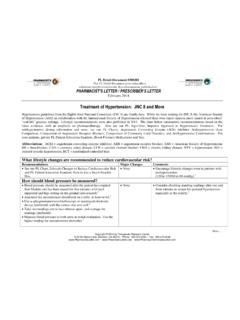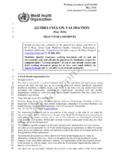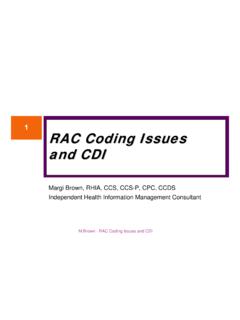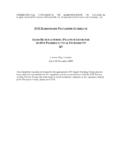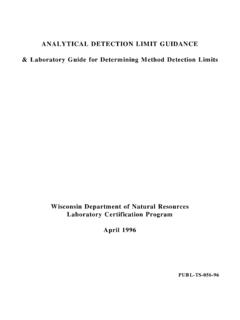Transcription of Public Use Blood Pressure Kiosks: A Guide for Clinicians
1 1 Public Use Blood Pressure kiosks : A Guide for Clinicians Bruce S. Alpert, MDa, Richard A. Dart, MDb, and Domenic A. Sica, MDc aDivision of Pediatric Cardiology, University of Tennessee Health Science Center, Memphis, TN, retired; bCenter for Human Genetics, Marshfield Clinic, Marshfield, WI; cClinical Pharmacology and Hypertension, Virginia Commonwealth University, Richmond, VA Introduction Out-of-office Blood Pressure (BP) values have become an integral part of the diagnosis and treatment of disease, especially hypertension. These BP measurement techniques include 24-hour ambulatory BP monitoring, home measurement, and Public -use kiosks . Recently, Alpert et al published a peer-reviewed discussion relating to kiosk BP,1 highlighting several critical issues relating to accuracy and reliability of many BP kiosks .
2 The Food and Drug Administration (FDA) published a consumer health information bulletin2 in 2014 referencing the shortcomings of many kiosks and the frequently inaccurate BP values obtained. The FDA recommended to the Public that if a person had questions relating to BP kiosks that he/she should ask his/her doctor for advice. We know of no published guides to which physicians, nurse practitioners, and pharmacists can confidently refer. We hope this clinical Guide will provide valuable information relating to: 1) the process of validation of kiosks for accuracy; 2) the size of the cuff integral to the kiosk; 3) the use of out-of-office BP values. validation testing The United States has a national standard for validation of non-invasive sphygmomanometers, whether for hospital, home, or Public Although the standard is "voluntary," Clinicians expect if a device is on the market it has passed tests demonstrating accuracy.
3 Routinely, all professional-grade sphygmomanometers sold in the United States have passed the American National Standards Institute/Association for the Advancement of Medical Instrumentation/International Standards (ANSI/AAMI/ISO) requirements. The FDA does not require that devices specifically pass this testing in order to meet the requirements for clearance, but allows other data supporting safety and efficacy to be used instead. In the publication by Alpert et al1 the authors highlight that one kiosk, manufactured by PharmaSmart, submitted a peer-reviewed publication5 documenting AAMI/ISO approval. Cuff size All clinical guidelines recommend the width of the occluding BP cuff be at least 40% of the limb circumference.
4 At a hospital or clinic, a medical staff member selects the appropriate cuff size for the limb of each patient from a range of available cuffs. For home use, a pharmacist should be available at the point of purchase to help each patient select the appropriate cuff size to promote accurate readings. kiosks , on the other hand, are free-standing units. The kiosk has a single-size cuff designed into the unit. The user does not have the opportunity to select a cuff of appropriate size for his/her arm. Blood Pressure readings performed with a cuff that is too small for an arm may give erroneously high BP values. Alpert et al summarized the current arm sizes of United States citizens1 and stated that the average United States male has an arm circumference of cm.
5 For most kiosks , the maximum arm circumference that can fit into the cuff is 33-34 cm. That 2 means almost half of the United States population cannot expect to use those kiosks and obtain an accurate BP reading. In the United States alone, there are over a million kiosk readings done per day. The Public health implications of this magnitude of incorrect BP readings being used for diagnosis and management of disease are of serious concern. Because hypertensive patients tend to have higher body mass indexes than normotensive people, current kiosk cuff sizes are too small for an even higher percentage of the hypertensive population. Thus, until the cuff size issue is corrected and all kiosk devices pass the accepted AAMI/ISO standards, the results of BP readings from such kiosks should not be acknowledged as trustworthy.
6 The AAMI Sphygmomanometer Committee, which includes FDA members, is currently working on additional standards requirements for kiosks to require that clearance of devices claiming accuracy for the general population will require BP measurements to be properly taken on arm sizes representing 90% or more of the adult general population. PharmaSmart has a unique cuff technology that is not limited by arm circumference. clinical use of out-of-office BP Most Clinicians have a solid working knowledge of BP measurement in the office setting and, in many instances, an equal appreciation of the nuances of in-home determinations. Assumptions made in these settings may not apply to the Public BP kiosks using single size Blood Pressure cuffs.
7 Clinicians are often faced with the decision as to whether the occasional in-office reading is an adequate basis for developing or modifying a treatment plan for hypertension or whether out-of-office readings can be reliably substituted to derive an optimized antihypertensive medication regimen. The kiosk approach to BP measurement presents a quandary to both patient and physician if it may not provide reliable information as when the kiosk has not undergone ANSI/AAMI/ISO validation and if an inappropriate size cuff is used, raising management questions. In conclusion, kiosk BP values can be of use in the diagnosis and treatment of patients, especially for the diagnosis of hypertension. The physician and patient need to be aware of the validation status, not just FDA clearance, and be knowledgeable about proper cuff size effects on BP measurement accuracy.
8 It is our hope that all kiosk BP manufacturers will undergo independent validation of their devices using AAMI recommendations, or another acceptable standard, to foster confidence in the ability of kiosks to provide BP readings accurate enough to be useful in clinical care management. References 1. Alpert BS, Dart RA, Sica DA. Public -use Blood Pressure measurement: the kiosk quandary. J Am Soc Hypertens 2014; 8: 739-742. 3 2. Food and Drug Administration. (2014, June 24). Blood Pressure Monitoring kiosks Aren t for Everyone. Retrieved from 3. Association for the Advancement of Medical Instrumentation. Non-invasive sphygmomanometers - Part 2: clinical validation of automated measurement type.
9 ANSI/AAMI/ISO 81060-2: 2013. Arlington, Virginia: Association for the Advancement of Medical Instrumentation; 2013. 4. Alpert BS. Are kiosk Blood Pressure readings trustworthy? Blood Press Monit 2012;17:257-8. 5. Alpert BS. validation of the Pharma-Smart PS-2000 Public use Blood Pressure monitor. Blood Press Monit 2004; 9:19 23. Correspondence to: Bruce S. Alpert, MD 1350 Poplar Ridge Dr. Memphis, TN 38120 Tel: 901-229-3719 Fax: 901-757-8181 E-mail.
